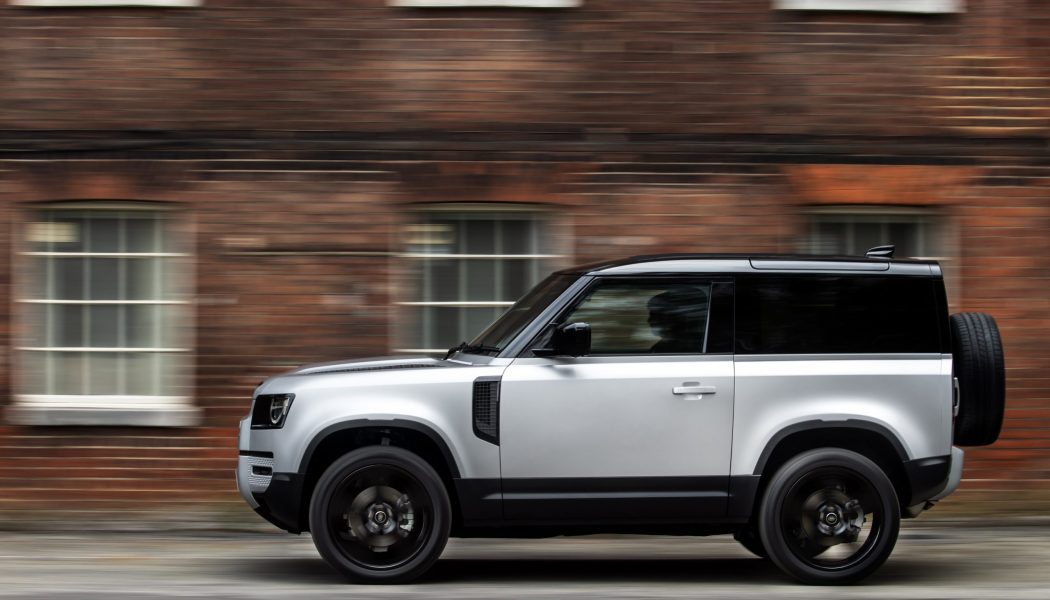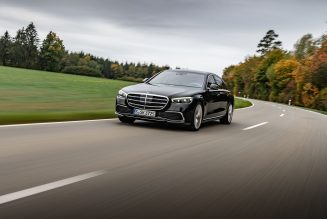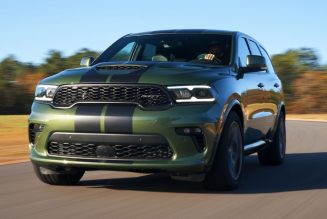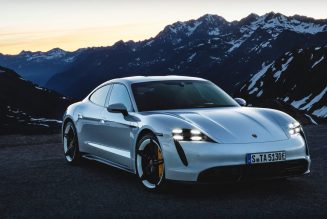Less is more. Well, maybe. In the case of the 2021 Land Rover Defender 90, less is most definitely less—17.1 inches less, to be precise. Make no mistake, the short-wheelbase version of our 2021 SUV of the Year winner is still a good thing, offering, like its longer sibling, a truly unique combination of luxurious refinement on-road and Jeep-like capability off-road. But whether less of a good thing is actually … a good thing … depends on what you’re going to do with it.
The Land Rover Defender 90 is built on the same high-strength, heavy-duty D7x aluminum architecture as the Defender 110. It shares the same powertrains, transmission, suspension, brakes, wheel and tire combinations, many trim items, and a number of body panels with the 110. The family resemblance is obvious, inside and out. But the 90 is very much its own device: Only 60 percent of its parts are shared with the 110.
In simple terms Jaguar Land Rover body engineers chopped 17.1 inches out of the central floor section of the Defender 110’s D7x platform and joined together what was left to create the 90. “Both front and rear crash structures are the same for 90 and 110,” Defender chief engineer Stuart Frith confirms. Other unique architectural elements under the 90’s skin include the fuel tank, the second-row seat structure and mounting, the rear subframe forward mounting structure, the springs and stabilizer bars, the exhaust, and the electrical wiring.
Externally, the Defender 90 shares everything ahead of the windshield with the 110. The vertical panel at the rear, the rear lights, and the rear door are shared, as well. The B-pillar has been pushed back, and the front doors are longer to allow access to the rear seats, and the rear quarter panels and the roof are unique to the short-wheelbase version.
The roomy Defender 110 looks suavely practical. The stubby Defender 90 looks ready to party. Our Defender 90 X P400, with its blacked out hood, dark wheels, privacy glass, and leather-trimmed interior with high-end audio system, seemed more suited to the urban jungle than the real thing, more ready for a primo parking spot outside a trendy nightclub than grinding up a muddy, rock-strewn slope in low range. So is the Defender 90 a purposeful tool or playful toy?
Chief engineer Frith is in no doubt. “We wanted to reduce the wheelbase as much as possible to optimize the ramp break-over angle for off-road capability,” he says. With the air suspension raised from its normal ride height of 8.7 inches to the off-road setting of 11.5 inches, the Defender 90 thus has a 31-degree breakover angle compared with the Defender 110’s 28 degrees. Approach and departure angles—38 and 40 degrees, respectively—are identical to the 110’s, but the better breakover and tightened turn-circle make the 90 just that much more maneuverable when the going really gets tough.
The Defender 90 feels more agile on the road, too. With the smooth 3.0-liter straight-six under the hood, JLR estimates the 90 will accelerate from 0 to 60 mph in 5.7 seconds (we measured 6.5 seconds for a 110 with this engine). Turn-in is noticeably sharper than in the 110; the steering ratio was kept the same as that of the longer-wheelbase Defender to enhance response, Firth says, though the steering assistance and stability control algorithm calibrations are unique to the 90. And the Defender 90’s rear stabilizer bar is about 20 percent smaller to compensate for the difference in weight transfer under cornering and braking.
The ride is still plush and controlled. The 90’s shock calibration is very similar to that of the 110, but its spring rates are slightly softer—about 10 percent softer, dependent on powertrain and features specified, Firth says—because of its lower overall weight. Although it’s a little more alert than the 110, the fundamental handling balance is therefore much the same. The biggest difference between the two is that you feel more pronounced fore-aft pitching motions in the Defender 90, an inevitable function of the car’s shorter wheelbase.
The 90 is the lighter, quicker, more agile, more capable Defender, and with prices starting at $47,450 for a base four-cylinder model, undercutting the base 110 by 8.5 percent, it’s the most affordable, too. But it’s not necessarily the best Defender.
A 17.1-inch cut in wheelbase is huge, though when Jeep finally built a four-door Wrangler it settled on a wheelbase a massive 21.6 inches longer than the classic two-door. As a result, although the 90’s front doors are longer than those of the 110, accessing the rear seats requires patience and agility. The front seat backs flick forward, but you still have to wait as the seat motors slowly toward the front of the cabin before hitching up and squeezing past the B-pillar to get in. Once you’re in, the legroom is good, and because the 90’s rear seats are mounted higher, on a part of the D7x structure that is located behind the second-row seats in the 110, so, too, is visibility. But the higher floor means you can’t slide your feet under the front seats.
With the front jump seat—a $900 option—installed to give three abreast seating, the Defender 90 will genuinely carry six passengers. Only problem is, it will struggle to carry anything else. The load space behind the rear seats is tiny; though the height and width are the same as in the five-seat 110, the distance between the rear seats and the rear door is just 18.1 inches, half that of the bigger Defender. And because the rear seat backrests are naturally angled rearward, dramatically cutting the distance between the top of the seats and the rear door, it’s not a particularly useful space, which explains why the 90’s claimed luggage capacity of 15.6 cubic feet is less than half the 110’s 34.0.
Folding the Defender 90’s rear seats forward increases the length of the load space to 51.7 inches and the load capacity to 58.3 cubic feet, but the numbers flatter to deceive because a 4-inch-high cross-car beam at the base of the rear seats means the load space floor is not flat.
Bottom line: Although the 90 has the sportier swagger of the two Defenders, it’s not as well-rounded a vehicle as the 110. Yes, you get a little more performance, a little more agility, and a little more capability (though only in truly extreme off-road situations) for a little less money. But in truth the differences aren’t all that great.
A tiny handful of enthusiasts will lust after the 90 as the ultimate off-road Land Rover, but most Defender 90s will—like all the short-wheelbase Jeep Wrangler Rubicons that never see a dirt road—be purchased by urbanites who want a “hey, look at me” vehicle to take to the mall or the beach. For them, the Land Rover Defender 90 is the 21st century version of the personal luxury coupe.
| 2021 Land Rover Defender 90 | |
| BASE PRICE | $47,450 -$82,560 |
| LAYOUT | Front-engine, 4WD, 5-6-pass, 2-door SUV |
| ENGINE | 2.0L/296-hp/295-lb-ft turbo DOHC 16-valve I-4; 3.0L/395-hp/406-lb-ft turbo- and e-s’chgd DOHC 24-valve I-6 |
| TRANSMISSION | 8-speed auto |
| CURB WEIGHT | 4,750-4,850 lb (mfr) |
| WHEELBASE | 101.9 in |
| L x W x H | 170.2* x 78.6 x 77.5 in |
| 0-60 MPH | 5.7-6.7 sec (mfr est) |
| EPA FUEL ECON | 17/22/19 mpg** |
| ENERGY CONSUMPTION, CITY/HWY | 198/153 kW-hrs/100 miles** |
| CO2 EMISSIONS, COMB | 1.02 lb/mile** |
| ON SALE | Currently |
| *180.4 inches including rear-mounted spare tire | |
| **3.0-liter models (2.0-liter not yet rated) | |









